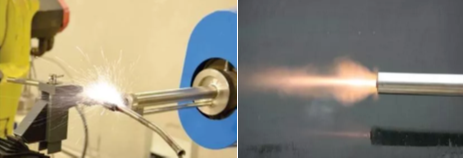

Thermal spray technology is a new technology for strengthening and protecting material surfaces. Using different heat sources and spraying equipment, anti-corrosion, wear-resisting, anti-wear, high temperature resistance, oxidation resistance, heat insulation, insulation, conductivity and microwave radiation resistance can be prepared. A range of coatings with multiple functions.
Flame spray technology can repair old equipment and use scrap in equipment maintenance, so that scrapped parts can be "revived"; it can also be strengthened and pre-protected in the manufacture of new products to give them "longevity". It can save a lot of energy, save materials, improve efficiency and reduce costs. It is particularly suitable for my country's national conditions and in line with my country's current economic policy. It is an important practical technology for energy saving, emission reduction, low energy consumption and high efficiency advocated by the state.
The history of thermal spraying
Flame spray spray technology has been around for over a hundred years since Dr. M.U completed the original molten metal spray equipment. Schoop in Switzerland in 1910.
Initially, flame spray spraying was mainly used for spraying decorative coatings, mainly oxyacetylene flame spraying or arc spraying of aluminum and zinc wires. In the 1930s and 1940s, with the improvement of flame and arc wire spraying equipment and the advent of flame powder spray guns, thermal spray technology evolved from the initial decorative coating spraying to the use of wire to repair and spray mechanical parts. Aluminum or zinc as anti-corrosion coatings for steel structures.

With the successful development of explosive flame spray technology and the subsequent development of plasma spray technology in the 1950s, thermal spray technology has been widely used in aerospace and other fields. During the same period, self-fluxing alloy powders were successfully developed, which made it possible to eliminate pores in the coating through the coating remelting process, achieve metallurgical bonding with the substrate, and expand the application field of thermal spraying technology.
Supersonic flame spraying technology was successfully developed in the early 1980s and became widely used in the early 1990s, expanding the application of WC-Co carbide coatings from aerospace to various industrial fields. The emergence of high-energy plasma spraying technology with a power of up to 200kW, supersonic plasma spraying technology, and axial powder-feeding plasma spraying technology (especially the initial supersonic plasma spraying technology) is to further effectively use thermal spraying technology in various industrial fields . provides powerful means.
my country's thermal spraying technology began in the 1950s, when Wu Jianchun and others established a domestic expert professional spraying factory in Shanghai, developed oxyacetylene flame wire spraying and electrospraying equipment, and developed metal spraying business.
In the 1960s, some military industrial units began to study plasma spraying technology (such as Beijing Institute of Aeronautics and Technology, 703 of the Rocket Technology Research Institute of Aerospace Corporation, 410, 420, 430 of the Aviation Department, etc.), and began to be applied to my country's military industry.
In the mid and late 1970s, a variety of acetylene flame metal powder spraying (smelting) equipment and various nickel, iron, cobalt-based self-fluxing alloy powders and composite powder spraying materials appeared, which laid the foundation for the rapid development of thermal energy. spray technique. solid foundation. Thermal spray materials are the "cooking food" of thermal spray technology. The increase in the variety of materials and the improvement in performance will directly improve the quality of the coating.
It is worth mentioning that, at this stage, the Beijing General Research Institute of Mining and Metallurgy and other units have developed exothermic spray materials, such as nickel-clad aluminum and various composite powder materials, which have broadened the application scope of coatings. Bringing the vitality of my country's thermal spraying technology, this stage can be said to be the primary stage of my country's thermal spraying technology development. Although some progress has been made at this stage, overall progress has been slow. It wasn't until the mid-to-late 1970s and early 1980s that it gained a relatively rapid rate of development. developing. Especially after the former State Economic Commission listed thermal spraying technology as a national key promotion project, the technology developed rapidly and achieved considerable economic benefits.
From October 21st to 27th, 1981, under the auspices of the State Economic Commission and the State Science and Technology Commission, the first National Thermal Spraying Conference was held in Beijing. It was announced at the meeting that, under the leadership of the National Economic Commission, the National Thermal Spraying Cooperation Group was established, which is affiliated to the Beijing General Research Institute of Mining and Metallurgy. The cooperation team contacted the State Economic and Trade Commission, the technical bureaus of the science and technology departments of the economic commissions of various provinces, municipalities, and autonomous regions, as well as large and medium-sized enterprises and colleges and universities. Research institutions. Spray technology network system.
Hot information

